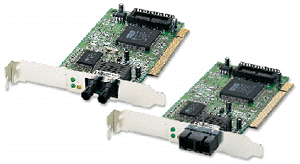
 |
Neon-komputadórComputer Users Manual, Ministry of Foreign Affairs and Cooperation, Democratic Republic of East Timor
|
|
Languages EnglishPortuguese Índice IntrodcutionChapter II: Networks and Communications Basic ConceptsModems Integrated Services Digital Network(ISDN) Leased-Lines CATV ("Cable Modems") Direct Subscriber Lines Network Interface Cards Network Typologies Repeaters, Hubs and Switches Bridges, Routers and Brouters Wireless Ethernet Modem Protocols OSI and TCP/IP Other Network Protocols TCP/IP Lower and Middle Layers TCP/IP Upper Layer: Applications The Internet Chapter III: Operating Systems Chapter IV: Applications Chapter V: Basic Coding and Programming Chapter VI: Basic System Administration Appendicies: Ministry Policy Ministry Hompage |
Network Inferface Cards (NIC) and CablesPersonal computers tend to have their network interface adapter in the form of a card, or Network Interface Card (NIC) rather than being built in to the system itself, although the latter is not unknown. The choice of NIC should be determined by the maximum speed of the network protocol, but backwards compatibility should also be kept in mind if necessary. For example, most Fast Ethernet cards are also capable of supporting the standard Ethernet's 10mbps bandwidth. A NIC should also be capable of operating in half-duplex (send or receive in a single operation) and full-duplex (send and receive in a single operation), as the latter option significantly enhances performance if switches are used in the network. Nearly all contemporary computers often have the option for PCI rather than ISA NIC's - these should be taken whenever possible, as PCI has a 33mhz bus speed (compared to 8.33 for ISA) and a 32-bit width (compared to 16-bit with ISA). These exact figures do vary, but the general intention should be clear - PCI has greater bandwidth. Note that ISA NICs can't support speeds above 10mbps, so therefore Fast Ethernet and Gigabyte Ethernet are out of the question. Ethernet network adapters cards usually have one of three connections, as the graphic below illustrates. Resembling a large telephone connector, the RJ45 connector is the most common, used for Unshielded Twisted Pair cables, and is universal throughout the Ministry of Foreign Affairs and Cooperation. UTP is the only cable type supported by Fast Ethernet and Gigabyte Ethernet as well. The older, BNC (Bayonet-Neill-Concilman) connectors are used for those Ethernets that use thin coaxial cable and the DB 15 pin connector are used for those networks which operate with a thick coaxial cable.  |
Ministry of Foreign Affairs and Cooperation, GPA Building #1, Ground Floor, Dili, East Timor
Website code and design by Lev Lafayette. Last update August 20, 2003